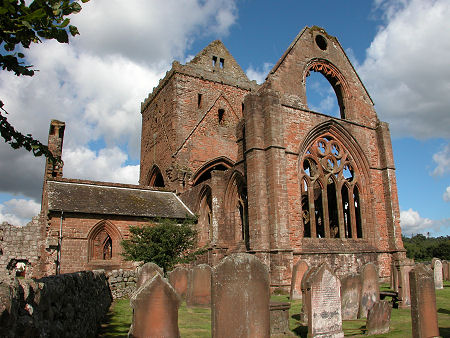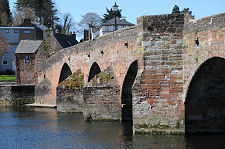 Sweetheart Abbey |
Devorgilla, Lady of Galloway, lived from 1210 to 28 January 1290. Her name is also sometimes given as Dervorguilla, Dearbhfhorghaill, Derborgaill or Dearbhorghil. One of the most powerful women of the age, she was hugely influential in her own right, and was the mother of one Scottish King, John Balliol, and the grandmother of another, Edward Balliol. She also left enduring legacies in South-West Scotland and far beyond it. The wider picture in Scotland at the time is set out in our Historical Timeline.
Devorgilla was the daughter of Alan, Lord of Galloway and his second wife Margaret of Huntingdon, a great-granddaughter of King David I.
At the age of 13, Devorgilla was married to John, 5th Baron de Balliol, whose family estates were based around Barnard Castle near Durham in England. In 1263 John Balliol (senior) became embroiled in a land dispute with Walter Kirkham, the Bishop of Durham. Balliol was adjudged to be in the wrong, and had to make penance, part of which took the form of founding a College for the poor at Oxford University. Devorgilla's own fortune was considerably greater than that of her husband, and after his death in 1268 it fell to her to put Balliol College on a more secure footing. This she did in 1282, making a permanent endowment to the college and establishing a Code of Statutes that remains in place today.
Lady Devorgilla also took steps to ensure John Balliol (senior) was remembered on Scottish soil. On 10 April 1273, she signed a charter establishing a new Cistercian abbey 6 miles south of Dumfries in memory of her husband. The abbey was initially called New Abbey. Lady Devorgilla's love for her departed husband extended to carrying his embalmed heart around with her in an ivory box with enamelled silver trimmings. After her death in 1290 she was buried in the sanctuary of the abbey church she had founded, and on her instructions the casket containing her husband's heart was buried beside her.
In tribute to her love for her husband, the monks of the abbey she had founded chose thereafter to call it Dulce Cor or Sweetheart Abbey. A testament to the enduring power of love, certainly: but to squeamish modern sensibilities this is a love story with a distinctly gruesome edge.
Lady Devorgilla and John Balliol had nine children. On 26 September 1290, Scotland was thrown into crisis when the only obvious heir to the throne, the young Margaret, Maid of Norway, died while en route to Scotland. Two years of chaos followed, and to avoid civil war, Edward I of England was asked to decide who had the strongest claim to the throne of Scotland. He selected John Balliol, the oldest surviving son of Lady Devorgilla and John Balliol (senior).
The interesting thing is that, had Lady Devorgilla still been alive when the Maid of Norway, died, instead of dying eight months before her, then Devorgilla, as the granddaughter of King David I, would have been the obvious candidate for the crown of Scotland. This might well have avoided the need to involve Edward I in deciding the succession, and resulted in a Balliol line thereafter that was not fraught with the problems that beset and eventually overcame both King John Balliol and King Edward Balliol. One of the (many) "what ifs?" of Scottish history...
Lady Devorgilla is better remembered than most who lived in her era. Balliol College, Oxford and Sweetheart Abbey both stand as a testament to her (though the latter looked rather better before the Reformation). Her name is also given to Devorgilla Bridge, the old bridge over the Nith at Dumfries. This was built in 1432, according to some accounts on the site of a wooden bridge Devorgilla had built in the 1260s.


